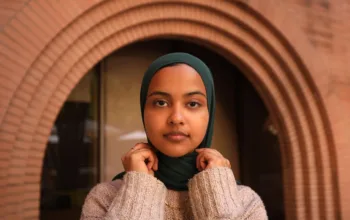First came soy, then almond. But the people behind Oatly believe they’ve found the best possible milk.
It is at coffee shops — independent, third-wave, the good ones. It is in the grocery aisle. It is in the newspaper, on the internet, in Rep. Alexandria Ocasio-Cortez’s grocery cart. It is oat milk. It is everywhere.
The New York Times has documented “The Humble Ascent of Oat Milk,” illustrated with a very graphic GIF. “How Oat Milk Conquered America,” explained Elemental. “The Non-Dairy Milk You’re About to See Everywhere” promised Food & Wine. So it is official: The oats are happening.
One brand is responsible for this golden age of oats: Oatly, a Swedish company based in Malmo that has, for the past 25 years, been trying to make oats happen. The brand launched in the US in late 2016, first gaining fans, and then fanatics. When in 2018 there was a US product shortage, the ensuing frenzy made international news.
Oatly is a phenomenon that transcends both dietary restrictions — about 65 percent of the global population has some degree of lactose intolerance — and ethical concerns. Sandwich boards outside coffee shops brag: “We have oat milk!” Inside, they offer specialty oat milk lattes — lavender, turmeric — that are billed not as substitutes but as the main event. At Man Repeller, writer Harling Ross recounts her own ecstatic Oatly awakening. “It was weird,” she recalls, “but as I unceremoniously ran my tongue around the cup to collect every last trace of foam, I realized it was only weird because I wasn’t used to coffee being this delicious.” Sometimes, a coffee shop will serve her a different brand of oat milk, but she always knows. She is a true believer. Oat milk that is not Oatly “just doesn’t taste as good.”
Clearly, she is not alone. By the brand’s rough count, Oatly is now available at about 5,000 cafes in the US, plus about 2,500 retail stores, including Target and Whole Foods. If you would like to find some, you can use the brand’s handy Oat Finder to locate the Oatly nearest you. Oatly’s sales in 2018 were about $110 million, reports Bloomberg, up from $68 million the year before. This year, the company is expecting more than double that — $230 million by the end of 2019.
Unlike so many of its competitors, which offer wide-ranging product lines — if it exists in nature, someone is milking it — Oatly does one thing: oats. Oats are the message and the strategy, and according to Mike Messersmith, Oatly’s general manager, this singular devotion helps explain the brand’s success. “There’s a reason why we only do oats,” Messersmith tells me. “There’s a purpose behind it.”
/cdn.vox-cdn.com/uploads/chorus_asset/file/18968941/13_frozen_in_situ.jpg) Oatly
OatlyIt’s certainly possible to make excellent oat milk as part of a larger alt-milk portfolio, he says. “But I do think you can lose the rationale for why any of them individually have to exist.” How much can you really believe in oat if you are also selling soy and rice and almond?
But Oatly, Oatly believes in oats. Environmentally and nutritionally, the company argues, oats are the best option we have. “People might disagree with us, and that’s their opinion,” Messersmith says cheerfully. “And they may not like how it tastes. They may not believe in the sustainability message. They may have other preferences. But they can’t make the argument that Oatly doesn’t have a point of view about why we’re doing the thing that we’re doing.” The current product line includes not only oat milks but oat yogurts (“oatgurts”), as well as oat ice creams, which, as of this summer, are available in the US in seven flavors. One of them is oat.
You can define an era by its nondairy milk alternative. The demand is there: Some people can’t digest milk, and others are allergic to it, and others object to industrial dairy because of its treatment of animals, or workers, or the environment. Tofutti, an original icon of nondairy frozen treat space, was created so that Jews who kept kosher could avoid mixing milk and meat and still have ice cream for dessert. Dessert is important. So is coffee.
Not so long ago, we were a soy milk nation. From the 1970s up until the early aughts, soy was the reigning American non-milk milk. Soy has its advantages: It’s creamy. If you add some sugar and some thickeners, it’s not oppressively bean-y. It works well enough in coffee. It makes a serviceable ice cream. At first, it was for vegans and hippies, the allergic and intolerant, but by the 1990s, it had burst out of health food stores and into the mainstream. It wasn’t just a substitute; it was a superfood, with a growing list of health benefits. We had found the answer. It was soy.
But then, it turned out, maybe some of those health benefits had been overblown. Maybe, in fact, soy had some problems. Serious Eats documents the backlash: What if the phytoestrogens in soy — plant-derived molecules that look structurally like estrogen — were causing early puberty in girls and raising cancer risks? (Probably not.) What if soy was a plot to feminize real American men? (No.) And anyway, weren’t there environmental implications here? Didn’t soybeans embody everything wrong with industrial agriculture, from monoculture to deforestation?
You can still get soy milk almost everywhere, but its shiny promise is long gone. Soy milk was not magic, it turned out. After peaking at $1.2 billion in 2008, US soy milk sales began to steadily decline — around 15 percent a year, according to a source at the dairy company HP Hood.
But that was okay, because we had found almond. It lightened up our coffees and liquefied our smoothies and by the end of 2015, per Nielsen, it was outselling soy nearly three to one. Almonds seemed so clean, so fresh, so Californian; a simple nut, but a pure nut, and a healthy nut, and a trendy nut, Gwyneth Paltrow in nut form. Almond was familiar and nonthreatening and blended beautifully with greens. Unsweetened, it was lower-calorie than either soy or dairy. I would not call it creamy, exactly, but even in coffee, it mostly does the job.
Almond fit not only our diets but our self-image. Plant-based eating became shorthand, Refinery29 writes: It signaled not only that you “cared about the earth and its animals,” but that you saw yourself as part of that same system. Of course you cared about your health. Soy had paved the way for almond, and when it fell, almond was there to take its place, and for a moment, we were done. We had the answer now, and it was almond.
Except that maybe almonds maybe weren’t so great, either. The primary issue is environmental: California, which grows more than 80 percent of the world’s almond crop, is in the midst of perpetual drought. It takes 1.1 gallons of water to produce a single almond. Was this a good use of resources? Luckily, or perhaps not, most almond milk doesn’t actually contain all that many almonds. “It’s actually a water-based emulsion that you’re adding oils, a lot of sugar and gums to, and then just adding a couple of nuts on top,” Cheryl Mitchell, the chief scientist of Elmhurst Milked, told the Guardian in January.
We aren’t done with almond milk. Almond milk (or, as it often reads on packaging “almondmilk”) is still by far the top-selling nondairy milk. In July 2018, almond milk sales topped $1.2 billion, according to Nielsen, right where soy had been in its prime. (Soy, now a distant second, was down to $230 million.) But we’d seen its imperfections. Almond milk was a milk, but it was not our one true milk.
There was an opening. Oatly took it. We all could have jumped on the oat bandwagon two decades sooner. The Oregon-based Pacific Foods, for example, had been selling oat milk to prescient hippies since 1996. It was there, waiting. And then in late 2016, Oatly came and made the introduction.
Oatly was the brainchild of Swedish food scientist Rickard Öste. He’d been doing research on lactose intolerance, and was thinking about sustainable, nondairy alternatives. Is there anything more sustainable, and less bovine, than oats? Sweden already had a lot of them. Öste developed a process to “milk” the formerly unmilkable, using enzymes to liquefy oats into a rich and milk-like liquid, adding vegetable oil to adjust the fat content. It hit Swedish shelves in 1994, where it gurgled under the radar for the next 20 years.
“Nobody wanted it,” Oatly CEO Toni Petersson recalled to the New Yorker. In fact, until he signed on to lead the company in 2012, he’d never heard of it. But oats, it turned out, were exactly the opportunity he’d been looking for. The first thing to do was deal with the inherent marketing problem: How do you convince people not only that they can drink oats, but that they really want to? Unlike soy and almond, which both have robust histories — a proto-soy milk called doufujian was popular in 14th-century China, while almond milk has roots in medieval Europe — oat milk was an innovation of the 1990s. It does not fit with the general expectations of what people are supposed to drink.
/cdn.vox-cdn.com/uploads/chorus_asset/file/18968946/3_Chilled_Original.jpg) Oatly
OatlyWhat oats needed were ambassadors, tastemakers who could convince consumers that actually, oat milk was what was missing from their lives. Instead of launching in grocery stores, Oatly courted baristas at third-wave coffee shops, introducing them to the brand’s Barista Blend and selling them on the sex appeal of oats. “It created that discovery experience for consumers,” Messersmith says. Maybe people aren’t going to buy a carton of oat milk at the grocery store. It’s the Wild West, that place. But in a coffee shop, there’s an expert guide. People trust their baristas. Baristas could make the introduction: “We have this new product and we think it’s really great,” they’d say. “We know you normally don’t want cow’s milk in your coffee. Would you like to try this?”
They did. And then they kept trying it again. And again. Coffee shops couldn’t keep the stuff in stock, and by the middle of 2018, Oatly shortages ravaged the US. At the Wesleyan University cafe, in Middletown, Connecticut, Man Repeller’s Ross reported the lack of Oatly was causing unrest. “It’s been chaos,” one barista told her. “And pretty exhausting, telling dozens of people every day that we were out.” A barista in Manhattan reported that her customers were not weathering it well: “The responses slowly started becoming more and more aggressive, ranging from people saying ‘YOU’RE STILL OUT?’ or “WHAT’S TAKING SO LONG?’”
Oatly shines in coffee. It is pleasantly thick and a little bit sweet. It froths. It foams. “It’s got considerable body, comparatively,” says Molly Stanard, a barista at Peck’s in Brooklyn. She is not a particular fan of oat in hot drinks — cold drinks are another story — but “it does a much better job of blending in with the coffee” than almond or soy. For a while, before you could get it at the grocery store, some coffee shops would deal you a carton over the counter, if you knew who to ask.
Everything about Oatly is designed so that you know it’s not like other milks. The packaging has a DIY aesthetic, in unexpected color combinations — bright white and Sharpie black on muted earth tones — that is a little bit punk rock and a little bit Matisse. The copy is chatty and intense, and there is a lot of it, explaining what Oatly is and why it’s good and where it comes from (“it’s Swedish!”). On the website, Oatly excitedly tells you “what’s amazing” about each offering, as well as “what might be less amazing” — not organic; more added sugar; an additional acidity regulator. The sustainability report leads with the fact that 2018 was “slightly worse than last year!”
“Even if a company is honest about the things it is not good at,” Oatly’s creative director John Schoolcraft said, “it will just come off as being the type of person that people want to hang out with.” Oatly, your bumbling, lovable buddy, life of the hyper-ethical party!
So when Oatly wasn’t, say, so great at keeping up with the demand for Oatly, people kept wanting to hang out with it anyway. Oatly was a breakout star, catapulted from obscurity, who’d maybe accidentally overextended itself. It was just so excited to be here! If anything, the shortage was evidence of the brand’s humility. Who could have known it would be so successful so fast?
But it’s hard being a breakout star. Oatly created an oat market, and one consequence of that is that it also created its own competition. Last year, Quaker Oats announced a line of oat milks, which launched in January. Then in January, Califia Farms announced it was also launching oat milks: first a special barista version in February, and then an unsweetened at-home drink in April. Even major players in the dairy industry — currently at war with plant-based milk producers over what should and should not count as “milk” — are getting into the oat game. In January, HP Hood, a $2 billion legacy dairy company, launched Planet Oat, the company’s first branded nondairy offering.
They’d been looking for “the next almond,” says Chris Ross, VP of marketing and research development at HP Hood. In 2013, or maybe 2014, the company starting homing in on oat. “I liked the taste of it,” he says. “It’s really as simple as that. There is a certain creaminess about it, and a certain satisfying note that I didn’t see at the time in other plant-based alternatives.”
Every plant-based product needs an anchor — an occasion where the new thing is fun and safe and logical, a comfortable experiment. For almond, the anchor was smoothies, he says. For oat, it’s coffee. And for that, we can thank Oatly. “Oatly certainly did it the biggest,” says Ross. “You know, give credit where it’s due.” Oats had found their anchor, which “gave us a lot of courage to say now the time is right. Planet Oat is ready for market.” It is now the top-selling oat milk in the country, accounting for 36.4 percent of the category nationwide, according to data from IRI.
Oatly, for its part, declined to share specific sales data, but over email did cheerfully acknowledge the existence of growing competition: “We know we can’t make up the whole oatmilk market on our own!”
As Messersmith sees it, that is how it should be. The competition is only natural, because oats are just that good. “I think it would be incredibly hypocritical of us as a company if we said both that we believe oat is the best source ingredient — best product from a nutritional, environmental, sustainability basis — but then also we should be the only ones that do it,” he says. “I think the reality is, we would be thrilled if the entire category was nothing but oat milk tomorrow.” You cannot start a revolution if the revolution depends on you being the only soldier in the fight.
To him, the biggest threat isn’t other companies making oat milk, but rather other companies making oat milk badly, and so unjustly turning would-be oat fans off oat. But other good oat milks? If you believe in oat milk as much as Messersmith believes in oat milk, then that’s a win. It just means Oatly has to do it even better.
But — and we all saw this coming — oat milk isn’t perfect, either. It’s relatively high in carbohydrates and calories, compared to almond. It doesn’t have all the same amino acids as milk from cows. There are concerns about pesticides on oats, although Oatly itself is certified glyphosate residue free. The slightly nostalgic cereal milk taste doesn’t work for everyone. I’d asked Stanard to describe the flavor of oat milk to me. “Like oats,” she’d said.
And yet it is, for now, the future. Or at least, that is what Messersmith and Ross both hope. Next year, Oatly plans to open a second US factory in Utah, and another in the Netherlands, to keep up with European demand. The company just opened a new office in Shanghai.
/cdn.vox-cdn.com/uploads/chorus_asset/file/18968956/1_Barista_Edition.jpg) Oatly
OatlyIt’s true that right now oat milk sales still represent a tiny fraction of total US plant-based dairy sales — $29 million, by Bloomberg’s latest count. But if Ross’s predictions are right, that’s going to change. The current milk landscape is glutted with options, but only because nobody is happy. “It’s like that U2 song from the late ’80s, ‘I Still Haven’t Found What I’m Looking For,’” he says. Some consumers love the variety — a milk for every purpose! — but others are tired of sorting through the endless pros and cons. “They’re saying, you know what? I’m making trade-offs. And as long as I’m continuing to make trade-offs, I’m going to keep searching for the milk that’s just right for me.”
Three or four years from now, he sees a great milk shake-out coming, with not one winner but three: There will be dairy milk; there will be almond milk; and at the end of the day, there will be oat. In this newly stable market, consumers will pick their milk, or milk alternative, and they will stick to it. An oat drinker. An almond drinker. A cow.
But we are not there yet. If there is a reckoning coming, it is in the distance, and for now, the battle rages on. No alt-milk yet has quite convinced America it can be everything to everyone, which leaves room for alt-insurgents. There is, for example, a company in Texas making banana milk. Perhaps the greatest threat to the rising tides of oat milk is lab-grown dairy, which uses the same proteins in dairy but produces them without using lactose or enlisting cows.
Ross has found the milk he was looking for, and it is oat. Of all the current possibilities, it is the one with “few to no trade-offs,” he tells me. Certainly, that is Oatly’s bet. The company has no plans, now or ever, to expand beyond the oatosphere. “You’d have to change the name of the company, which would just be super hard,” muses Messersmith. “Hemply just doesn’t have the same ring to it.” How will they grow, then, I’d asked, which is an embarrassing question because the answer is so obvious: more oats.
I planned to conclude that there is no perfect milk, and maybe that is for the best. “There are infinite reasons to cycle between all of these,” Stanard had told me as we’d sampled coffees made with almond and soy and oat and cow. Like children, they each have their strengths and weaknesses; some are artistic, and some are athletic, and some steam beautifully for lattes. Isn’t it nice that you can make horchata with rice milk and put oat milk in your coffee and whip up a classic Alfredo with milk from a cow? Do we really need one milk to be everything to everyone? Is that even fun?
But maybe we do. Maybe the constant switching based on whim and occasion is an exhausting way to live. Maybe what we want is a one true milk, and maybe we can have it. “There’s going to be some consumers that love to bounce around,” Ross says.”But I think for 80 percent of the bell curve, you’re going to find people settling in and they’re going to pick a lane and they’re going to stick to it.” And when they do, oat will be there, waiting, creamily, to greet them.
Sign up for The Goods’ newsletter. Twice a week, we’ll send you the best Goods stories exploring what we buy, why we buy it, and why it matters.
Author: Rachel Sugar
Read More



